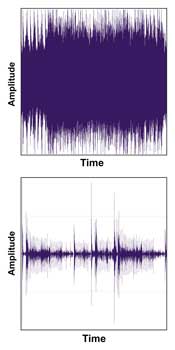
Most reputable manufacturers use standardized power testing to rate their loudspeakers. These methods define the type of waveform, time duration, crest factor and a few other metrics.
These tests are designed by experts to simulate real-world demands on loudspeakers.
They tell you how long the loudspeaker survived under the described conditions. Since they can’t possibly know how the end user will use (or abuse) the product, they can’t guarantee that you won’t blow it up.
Power ratings are very useful for comparing the relative differences between products from the same manufacturer.
When using them to compare one brand to another, make sure that the ratings are based on the same standard (i.e. AES, EIA-426B, etc.).
And even when the standards are used, the “honor system” governs the writing of spec sheets. Since overrated loudspeakers generally don’t kill or maim people, the government doesn’t require validation of power ratings. Only in “Auditopia” are there “data police” that check all the ratings.
You can pinch yourself to wake up now. Also remember that large power ratings can be achieved with resistors (which don’t produce much sound!). That “Killbox 5000” might have a couple of water-heater elements as part of its crossover network.

10) What happens if my power amplifier is too large?
It’s better to have an oversized amplifier than an undersized one, provided that one stays within the thermal limits of the loudspeaker. A bigger amplifier is less likely to clip the signal. But there are limits here, too. A piston can only travel so far before it becomes non-linear.
If you hook a zillion watts up to a loudspeaker to provide 40 dB of headroom, and then someone drops a mic, you may see impressions of all of the cones in the metal grills. Over-excursion kills fewer loudspeakers than heat, but it must still be considered.
11) Should I use a rubber band or a chain to pull my boat trailer?
I had to get one in regarding reactance. There’s a big difference between the impedance of a real loudspeaker and that of the non-inductive load resistors used to test many amplifiers.
Reactive loads reflect power, and the amplifier has to deal with this. Amplifiers with extended bandwidths are often unstable into reactive loads. If presented the choice between a “20 Hz to 40 kHz” bandwidth spec and a “DC to gamma rays” spec, I would pick the former.
The Point
How did you do? Hopefully this series has provoked some thought. Power ratings are useful for getting a general idea of the performance of a device, but as I have shown, there are many variables and caveats when you assign numerical ratings to amplifiers and loudspeakers.
Don’t give these numbers any more or less attention than they deserve. They are but one piece of the puzzle, and probably not the most important piece.
Also, don’t be afraid to do your own power testing. The A/B comparison of two products is still the best way to tell the difference between them, regardless of what the numbers say. Music at full volume might be a more relevant power test for your system than pink noise.
Just be sure going in which party is paying for the toasted voice coils.
SynAudCon is now offering “Audio Applications – System Optimization & EQ” as web-based training. Click the link to see the related article.
